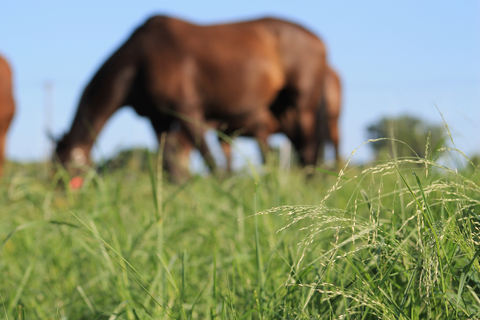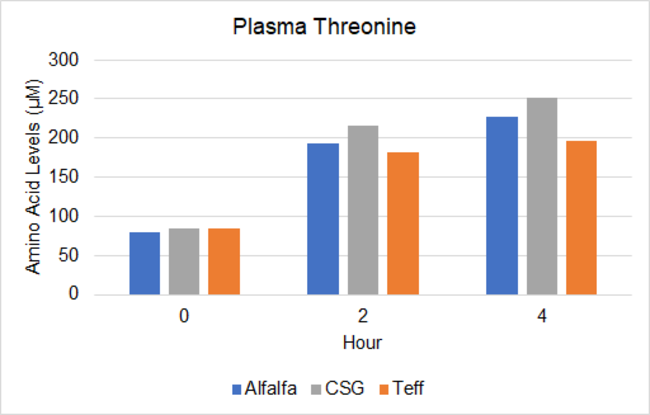Quick facts
- Cool-season grass and alfalfa are higher in amino acids than teff.
- When grazed by horses, the only difference in blood amino acid levels was a decrease in threonine levels for horses grazing teff.
- While alfalfa and cool-season grasses were higher in protein and lower in fiber, the horses grazing teff had similar blood amino acid response.
Forage plays a key role in the horse’s diet. Horses usually eat cool-season grasses, legumes (e.g. alfalfa) or warm-season grasses (e.g. teff) as hay or pasture to meet their forage needs.
These forage types differ widely in their nutritional content. One main difference is their protein content. Legumes usually have the highest protein content (CP), while warm-season grasses usually have the lowest.
Protein affects growth, muscling and muscle repair in horses. While crude protein is commonly used to estimate protein content, amino acids are a better measure of protein quality. Amino acids are the building blocks of protein.
We looked at the amino acid levels of each of these forage types and their effects on horses.
Testing for amino acids
- We grazed six aged horses on cool-season grass (Kentucky bluegrass and orchardgrass mixture), legume (alfalfa) and warm-season grass (teff) pastures.
- We took forage and blood samples before turning out the horses and again two and four hours following turn-out.
- We looked at the nutrient and amino acid content of the forage and the amino acid content in the blood samples.
Results
The forage types each differed in nutrient content during the grazing period (see table 1).
Alfalfa and cool-season grasses had a higher digestible energy (DE) and CP content compared to teff. In comparison, the fiber levels (ADF and NDF) were highest in teff.
A higher CP content relates to a higher amino acid content, but fiber content can affect the availability of the amino acids to the horse. As the fiber content increases, the amino acids present become less available to the horse. Lower CP and higher fiber contents in teff suggest that this forage contains less amino acids, which are less available to the horse.
To look more closely at protein, we evaluated amino acid profiles (see table 1).
Amino acids were often highest in cool-season grasses and lowest in teff. Moderate amino acid levels were present in alfalfa.
Despite these differences, we compared the lysine amino acid content in this study to the lysine needs of different classes of horses. Most classes of horses (except growing horses and pregnant mares) would meet their lysine needs if they ate 1.5 percent dry matter (DM) of their body weight in teff pasture. This suggests the forage amino acid differences may not cause physiological problems in the horse.
Table 1. The nutrient content and essential amino acid profile of forage grazed by horses in July 2016.
| Nutrient | Alfalfa | Cool-season grass | Teff |
|---|---|---|---|
| DE, Mcal kg-1 | 2.37 | 2.22 | 2.01 |
| CP, % DM | 23.3 | 24.1 | 15.4 |
| NDF, % DM | 43.2 | 53.4 | 65 |
| ADF, % DM | 33.1 | 30.9 | 37 |
| Amino acid, % DM | |||
| Arginine | 0.89 | 1.07 | 0.57 |
| Cystine | 0.22 | 0.25 | 0.14 |
| Histidine | 0.43 | 0.43 | 0.23 |
| Isoleucine | 0.95 | 1.01 | 0.58 |
| Leucine | 1.57 | 1.75 | 1.02 |
| Lysine | 1.17 | 1.25 | 0.72 |
| Methionine | 0.33 | 0.41 | 0.24 |
| Phenylalanine | 1.02 | 1.18 | 0.65 |
| Threonine | 0.81 | 0.92 | 0.51 |
| Tryptophan | 0.28 | 0.3 | 0.15 |
| Tyrosine | 0.57 | 0.61 | 0.33 |
| Valine | 1.16 | 1.28 | 0.74 |
Regardless of forage type, the amino acid levels before grazing remained the same for all horses.
Amino acid, threonine, could be limiting in horses grazing teff. While most amino acid levels in the horses’ blood were not different between forage type, the levels of threonine showed differences after four hours of grazing (see figure 1). Horses grazing cool-season grasses had higher threonine levels in their blood than horses grazing teff.
Reviewed in 2021



